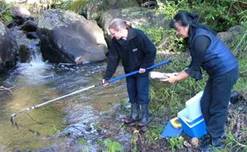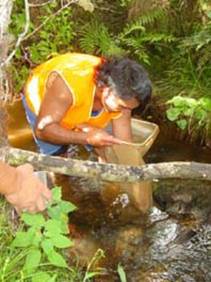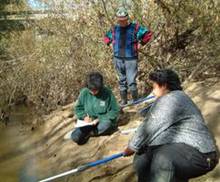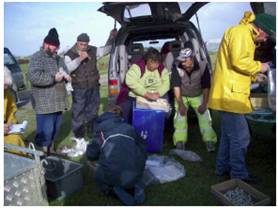18.4 What is being done?
Policy
Regional Policy Statement
The Regional Policy Statement (RPS) for Northland (NRC 2002) contains the following objective in section 14: Involvement of Tangata Whenua:
· Involvement of tangata whenua in the management of the natural and physical resources of the region in a manner that recognises and respects tangata whenua and ahi kaa as kaitiaki o nga taonga tuku iho (guardians of the treasures of their ancestors, as handed down).
The objective under section 24: Heritage Protection of the RPS, also relates to tangata whenua involvement and cultural significance. This objective is:
· Protection and where possible, enhancement of the cultural, historic and amenity values of heritage features.
For more information refer to the Regional Policy Statement on the Council's website at the following link:
In the 2006/2007 financial year the Council had a contractual arrangement with Te Roopu Piritahi to act as policy advisors on new and plan changes to Councils resource policies and plans. They were also engaged to make recommendations on consultation and to assist with facilitation of wider Maori consultation.
The Council continues to develop a Best Practice document, which will outline a transparent and consistent process of consultation with regards to planning and policy development.
Council functions
The Council maintains a register of relevant iwi planning documents. The Council is required under section 66(2A)a to "take into account any relevant planning document recognised by an iwi authority and lodged with the Council, to the extent that its content has a bearing on resource management issues of the region" when preparing or changing a regional plan. These documents do not take the place of direct discussion with Maori.
The Council are also guided by relevant iwi policy documents when assessing and processing consent applications. Likewise, legislation such as the Te Uri o Hau Claims Settlement Act 2002, is carefully considered and adhered to as a statute, when processing applications for resource consents.
The Council circulates non-notified consent applications to provide Maori the opportunity to show whether they are an affected party.
Information sharing
The Council continues to distribute a panui (newsletter), Purongo Putaiao to those Maori on its database. The panui outlines activities of interest to Maori and opportunities for involvement in Council projects and processes. The panui has regular updates on the resource management plans, and encourages participation in local body elections (during election year) and input into the Annual and Long Term Council Community Plans.
The Council also contributes funding towards workshops/wananga on Council activities and processes. The Council continues to participate in workshops on request on any matters relating to Council business. For example, the Council was invited to a Kaitiaki Wananga alongside other groups and individuals such as Gail Tipa, author of the Cultural Health Index, Far North District Council and Department of Conservation.
Other involvement
The Council encourages Tangata Whenua involvement in the management of Northland's natural and physical resources by:
· Providing for Maori representation on the two Council standing committees, with decision making powers.
· Carrying out specific Maori consultation processes relating to resource management plans.
· Having policy that requires the circulation of all resource consent applications to Maori. For example, currently the Council, over and above requirements to circulate all notified consents to Maori and statutory responsibilities under the Te Uri o Hau Claims Settlement Act 2002, circulates for their information, non-notified consent applications to Maori who have expressed an interest in an area.
· Formalised working relationships with Maori through Memoranda of Understanding (MOU) such as the MOU between Te Uri O Hau Settlement Trust and the Council.
· Appropriate recognition of Settlement Acts and Maori Policy and Management plans such as Te Uri o Hau Claims Settlement Act 2002 and the Ngatiwai Aquaculture Management Area Policy.
The Council also recognises the value of education and advocacy through:
· The Council's environmental education programme, in which the Council and Kura Kaupapa Maori work together on environmental projects and the environmental education school curriculum guidelines.
· Specific funds available for schools/kura in order to implement environmental education projects.
· The Council offers free workshops on the Resource Management Act and the Council's consent, planning and monitoring processes for Maori.
· Treaty of Waitangi and basic Te Reo and marae protocol training for Council staff to ensure awareness of Maori culture and issues.
· A series of brochures on the consent application process that encourages applicants to consult with Maori before lodging consent applications.
Funding for Tangata Whenua
Where and when appropriate, the Council will contribute funding to tangata whenua through the Hapu Management Plan and the Joint Iwi Monitoring Funds.
Iwi/hapu environmental management plans
Iwi environmental management plans are a vision of how the management and protection of natural and physical resource can be achieved based on cultural and spiritual values of tangata whenua. (Ministry for the Environment, Te Raranga A Mahi 2000)
The Council supports the preparation of iwi/hapu management plans by providing advice and an annual contestable fund of $20,000 that iwi groups can apply to for the development of the environmental component of Iwi/hapu Management Plans.
More information on hapu management plans is available on the Council website at the following link:
Ngā Mahere Iwi/Hapū mō ngā Take Taiao — Iwi/Hapū Environmental Management Plans
Joint Iwi Monitoring Fund
 This fund which was established in 1996/1997 aims to provide Maori with the opportunity to undertake monitoring projects within Northland. It is an annual contestable fund of $10,000.
This fund which was established in 1996/1997 aims to provide Maori with the opportunity to undertake monitoring projects within Northland. It is an annual contestable fund of $10,000.
Previously funded projects include studies on freshwater macroinvertebrates, water quality monitoring (shown in the photograph right), kokako monitoring and shellfish surveys. See some of the examples below for more information.
Whenua (Land)
There are some Iwi groups who have worked with the Council in past years to eradicate pest plants and animals. Te Rarawa worked with the Council to gain Growsafe qualifications, which then allowed them to tender for various pest animal eradication programmes. Within this iwi (Te Rarawa) there was a group on the west coast who worked to establish the Herekino Ginger Landcare Group. This has grown to encompass the wider community.
Nga Whenua Rahui
Nga Whenua Rahui managed by the Department of Conservation funds the protection of indigenous ecosystems on Maori land. This includes biodiversity and ecosystem protection and can be used to meet the costs of survey work, fencing, plant nursery development, and pest and weed control. The land area in Northland protected under Nga Whenua Rahui is approximately 5,400 hectares as of November 2007.
One of the latest projects to be funded by Nga Whenua Rahui is fencing and management to exclude stock from Lake Omapere and associated waterways on Maori owned land in the Lake Omapere catchment. This project started in 2006 and includes 102.3 hectares of land. This funding was partly progressed through the Lake Omapere Restoration and Management Project, a joint project between the Lake Omapere Trust and the Council to restore the mauri of the lake.
Kokako Monitoring
Te Mahurehure Roopu Whenua Taonga Trust received funding from the Joint Iwi Monitoring Fund to carry out kokako monitoring in the Waima area from 2002 to 2004. This group has continued on with kokako monitoring and has carried out rat, possum and mustelid control in the areas where kokako populations are known.
NZ Archaeological Association site recording scheme
The New Zealand Archaeological Association (NZAA) has a national inventory of all sites of significance that have been recorded and registered with them, known as the NZAA Site Recording Scheme (SRS).
In 2001 the NZAA began a national programme to update the information on the SRS. By 2004 the Council had joined with the Whangarei District Council to look at an upgrade of the Whangarei district records.
The initial stage was a desktop review of the Whangarei district, from which NZAA were able to determine which sites needed revisiting to ensure accuracy and validity of their records. The second stage of the upgrade involved visiting sites which required validating, which was carried out jointly by local iwi representatives and an archaeologist for NZAA, with funding assistance from both the Whangarei District and Regional Councils.
When this project was completed, work began on the desktop review of the Kaipara and Far North districts. As the Council was the only organisation funding this project, only the initial stage was completed for both districts.
 Section 24 of the RPS for Northland discusses Heritage Protection. One of the methods of implementation for section 24 is to ‘assist iwi authorities to establish appropriate recordings systems for waahi tapu and other features of cultural significance." During 2007 the Council seconded a senior policy analyst to work with Te Uri o Hau to extrapolate information from their Waitangi Tribunal reports. This information related to sites of significance and cultural landscapes. An inventory was created which catalogued and referenced material making it readily available for use by Te Uri o Hau.
Section 24 of the RPS for Northland discusses Heritage Protection. One of the methods of implementation for section 24 is to ‘assist iwi authorities to establish appropriate recordings systems for waahi tapu and other features of cultural significance." During 2007 the Council seconded a senior policy analyst to work with Te Uri o Hau to extrapolate information from their Waitangi Tribunal reports. This information related to sites of significance and cultural landscapes. An inventory was created which catalogued and referenced material making it readily available for use by Te Uri o Hau.
Wai (water)
Freshwater macroinvertebrate monitoring
The Ngatiwai Trust Board has carried out and reported on the health of waterways around Whangarei several times over the last 10 years, using freshwater macroinvertebrates. Their first sampling and report was on the Whangarei Harbour catchment in 1996/1997. This work was successful due to the assistance of volunteers with technical expertise, the involvement of many local iwi and financial support from several sources, including the first year of the Joint Iwi Monitoring Fund.
Ngatiwai Trust Board has since carried out freshwater macroinvertebrate monitoring every year from 1999 to 2003, extending their monitoring to include more sites within their rohe.
Ngatiwai have used the findings from this work to identify areas with impacted water quality and in turn consulted with the Council about these findings and their concerns.
Water quality monitoring
 The Utakura Environmental Monitoring Group was established by local iwi concerned with the water quality of the Utakura River, especially as it has been severely affected by the weed infestations and algal blooms in Lake Omapere (Utakura River is the only outlet from Lake Omapere).
The Utakura Environmental Monitoring Group was established by local iwi concerned with the water quality of the Utakura River, especially as it has been severely affected by the weed infestations and algal blooms in Lake Omapere (Utakura River is the only outlet from Lake Omapere).
This group has been successful at gaining funding twice from the Joint Iwi Monitoring Fund and in total have carried out 12 months of water quality monitoring in the Utakura catchment between 2003 and 2007.
The group has used the knowledge gained and the results from this monitoring to increase awareness of water quality issues and encourage riparian management within the catchment.
Lake Omapere Restoration and Management Project
The aim of the Lake Omapere Restoration and Management Project was to develop and implement a voluntary lake management strategy that works towards improving the health of the lake and to help establish the Lake Omapere Trustees in their role as Kaitiakitanga. This was a joint project between the Lake Omapere trustees and the Council.
Tahati (coastal)
Shellfish surveys at Matapouri
Te Whanua O Rangiwhakaahu Maori Committee have carried out surveys of the pipi beds in Matapouri Bay on the east coast of Northland because of concern that pipi sizes were so much smaller at Matapouri Bay than those close by at Ngunguru. One pipi survey was carried out each year from 1999 to 2002, in both Te Wairoa and Parangarahu River, with support from the Joint Iwi Monitoring Fund.
In 2002 Te Whanua O Rangiwhakaahu completed a hapu management plan to guide the development and protection of their resources, including all kaimoana.
Whangarei Harbour Kaitiaki Roopu
The Whangarei Harbour Kaitiaki Roopu arose from a hearing as part of the resource consent process for Northland Port Corporation's application to construct a deep water port at Marsden Point.
The Hearing Commissioners recommended that the Northland Regional Council:
"i. In association with Rangiora Marae, work with all interested parties to develop an overall Kaitiaki harbour management structure to give practical effect to the Applicant's financial offer to initiate improvements to Whangarei Harbour. It is further recommended that consideration be given to providing statutory authority for this management mechanism by means of the Regional Coastal Plan."
Added to the above recommendation were the following conditions in Northland Port Corporation's resource consent, which state (in part):
"10 The Consent Holder shall pay to the Northland Regional Council up to $25,000 per annum toward scientific studies for the purpose of monitoring the effects of the development on the water quality and ecology of the Whangarei Harbour….."
"11 The Consent Holder shall pay to the Northland Regional Council $50,000 per annum for 10 years …..The purposes for the fund are to enable improvements to the health of the Whangarei Harbour, and should include:
· re-seeding shellfish beds
· study of New Zealand Dotterel nesting/roosting/feeding areas
· creating new feeding habitat for New Zealand Dotterel
· concerns of tangata whenua."
 One of the objectives of the roopu was to establish ways to minimise any adverse effects of the deep water port (including its construction) on the adjacent communities. Matters on which the Kaitiaki Roopu were expected to provide input included enabling the improvement of the health of the harbour, and the study and/or mitigation of the effects of the port development on waahi tapu, taonga and features of special interest to tangata whenua. Therefore the improvements, studies and/or mitigation include the concerns of Tangata Whenua and include shellfish reseeding, studies of the NZ dotterel and maintenance and enhancement of habitat of the dotterel and other shorebirds.
One of the objectives of the roopu was to establish ways to minimise any adverse effects of the deep water port (including its construction) on the adjacent communities. Matters on which the Kaitiaki Roopu were expected to provide input included enabling the improvement of the health of the harbour, and the study and/or mitigation of the effects of the port development on waahi tapu, taonga and features of special interest to tangata whenua. Therefore the improvements, studies and/or mitigation include the concerns of Tangata Whenua and include shellfish reseeding, studies of the NZ dotterel and maintenance and enhancement of habitat of the dotterel and other shorebirds.
Roopu members and others counting cockles during shellfish surveys (above right).
The roopu makes recommendations for funding from the annual Whangarei Harbour Health Improvement Fund and also has input into the Scientific Fund.
The Kaitiaki Roopu and Whangarei Harbour Health Improvement Fund have carried out and contributed to extensive work in the Whangarei Harbour over the past seven years. The Kaitiaki Roopu has actively been involved in shellfish reseeding trials (and the subsequent reseeding programme) and the ongoing monitoring and re-establishment of seagrass beds. The roopu has also made recommendations for other groups to receive funding such as the Friends of Matakohe/Limestone Island for composting toilets and lizard translocation. There has been a range of enhancement projects supported through this fund, as shown in table 1 (below).
Table 1: Summary of historic and proposed Whangarei Harbour Health Improvement Fund projects.
| Year | Applicant | Project |
2001/02 |
Auckland University | Subtidal benthic ecology survey |
| DoC | Shorebird enhancement works | |
| Friends of Matakohe Island | Composting toilet development | |
| Kamo High School | Assistance with notification costs of marine reserve proposal | |
| 2002/03 | NIWA | Shellfish reseeding investigation |
2003/04 |
NIWA | Shellfish reseeding trial |
| NIWA | Seagrass restoration investigation | |
| Ornithological Society of Northland | Shorebird habitat enhancement | |
2004/05 |
NIWA | Shellfish reseeding trial continuation and expansion |
| Volunteer workforce costs | Reimbursement of costs for monitoring of shellfish reseeding trials by volunteers | |
2005/06 |
NIWA | Shellfish reseeding trial continuation and expansion |
| NIWA | Seagrass restoration trials* | |
| Volunteer workforce costs | Reimbursement of costs incurred to volunteers | |
2006/07 |
NIWA | Seagrass restoration trials |
| Friends of Matakohe Island | Lizard Translocation: Year 1 | |
| Volunteer workforce costs | Reimbursement of costs incurred to volunteer workforce | |
2007/08 |
Proposed: NIWA | Shellfish Restoration; Completion of Parallel Trials and Project Synthesis. |
| Proposed: Friends of Matakohe Island | Lizard Translocation: Year 2 | |
| Proposed: Meryl Carter | Environmental Education at Takahiwai. |
*This work was not undertaken, as a funding application to the Ministry for the Environment's Sustainable Management Fund was declined.
Monitoring for viruses in shellfish
Local Maori had raised many concerns about the state of traditional shellfish beds and collection sites in and around Waitangi and Te Haumi. This was partly as a result of sewage pipe breakages and spills in the Bay of Islands over a number of years. A monitoring forum was set up by a group of local Maori, concerned for the health of locals who were dependant on the shellfish as a food source. The forum sought to have the area monitored with the view of restoring the mauri of the coastal area.
The Council established a monitoring programme for viruses in shellfish with technical expertise from the Institute of Environmental and Scientific Research (ESR). Shellfish from the Bay of Islands were studied between January 2004 to February 2006 to determine whether shellfish were contaminated with human enteric viruses from sewage (Greening and Lewis 2007).
The study showed that shellfish beds were frequently contaminated with human viruses over the two-year period. At two traditional shellfish gathering areas, human enteric viruses were detected in 19 of 49 shellfish samples. This is of concern as shellfish are a significant source of food for the local community. It was intended that further investigation and routine sampling would be established at selected sites in the future.
The Council has been working with local Maori collecting shellfish samples for testing. This has been an ongoing project with funding being granted to Te Pataka Matauranga Charitable Trust from the Council's annual Joint Iwi Monitoring Fund to assist them with sample collection costs.
